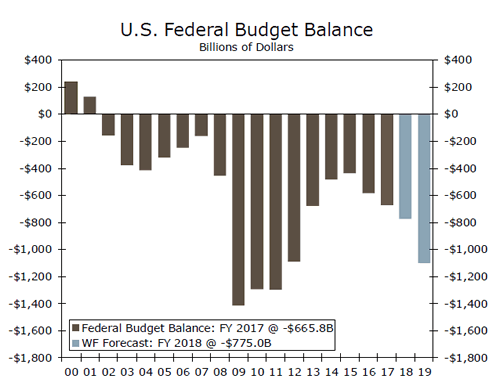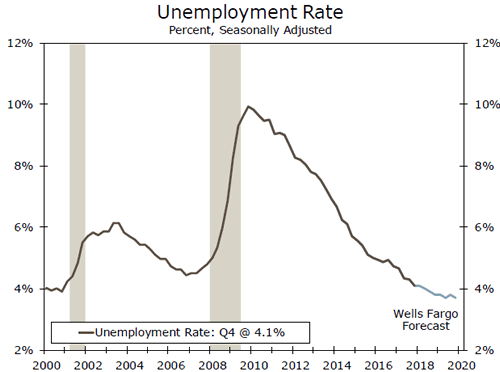U.S. Review
Inflation Comes in January, Is Here to Stay
- In a busy week of economic data releases, the leading story is the stronger-than-expected CPI reading to begin 2018. Headline CPI increased 0.5 percent in January, and registered a 2.1 percent year-over-year increase.
- Retail sales and industrial production each disappointed this month, falling well short of market expectations. Though each could have been affected by seasonal factors, it remains to be seen if firming inflation will affect consumer spending and if manufacturing output will keep pace with ISM strength.
Inflation Comes in January, Is Here to Stay
In a busy week of economic data releases, the leading story is the stronger-than-expected CPI reading to begin 2018. Headline CPI increased 0.5 percent in January, and registered a 2.1 percent yearover- year increase. While energy prices played a large role in boosting the CPI, core CPI, excluding food and energy prices, rose 0.3 percent, the largest gain since last January. While the year-ago gain is unchanged from December, core CPI has increased at a 2.9 percent three-month annualized rate. This indicates that yearago rates should strengthen in coming months. With inflation trending upwards recently as prices firm, we believe that the Fed will continue its tightening policy and raise rates three times this year.
Inflation is also rising on the producer side, as the Producer Price Index (PPI) for final demand rose broadly in January, by 0.4 percent. Both headline and core prices rose 0.4 percent, with increases in goods, services and construction. On a year-over-year basis, core PPI rose 2.5 percent, which is the strongest since 2014. Input prices for services has been slightly stronger than for goods, but the moderate rise indicates inflation should continue firming.
Retail sales data were released simultaneously with the CPI, and brought disappointing news. Retail sales growth came in 0.5 percentage points lower than expected, posting a 0.3 percent decline in January. The primary culprits for the drop were a 1.3 percent decline in motor vehicle & parts dealers’ sales, a 0.4 percent drop in furniture stores’ sales, a 2.4 percent drop in building material & garden equipment sales and a 1.2 percent drop in health & personal care stores’ sales. It appears that there are some seasonal factors in January’s report, as retail sales have typically been weaker during Q1 since the recovery from the Great Recession. Control group sales were expected to increase a solid 0.4 percent, but came in flat on the month. The weak retail sales report combined with stronger inflation data raise some concerns, however. Consumer purchasing power could be slashed as inflation picks up, which would certainly have a negative impact on retail sales moving forward. This will be something to keep an eye on.
Industrial production (IP) also underwhelmed in January, falling 0.1 percent despite market expectations of a 0.2 percent gain. Mining can be blamed for this, falling 1.0 percent, though it comprises just 13 percent of IP. However, manufacturing was flat on the month, which allowed mining to drive the headline. This marks the second straight month of unchanged manufacturing output despite lofty ISM readings, which could partially be due to hurricane-related disruptions. We expect manufacturing production to grow in coming months as the hard and soft data converge and regional manufacturing activity has picked up.
Housing starts more than doubled expectations and rose 9.7 percent in January, following an upwardly revised 6.9 percent drop in December. The South led the growth in both starts and permits, increasing 21.9 and 5.4 percent, respectively. Starts are a historically volatile series, but the jump confirms high homebuilder confidence as improving job and wage growth, along with low for-sale inventory, means builders are selling homes just as fast as they can be built.
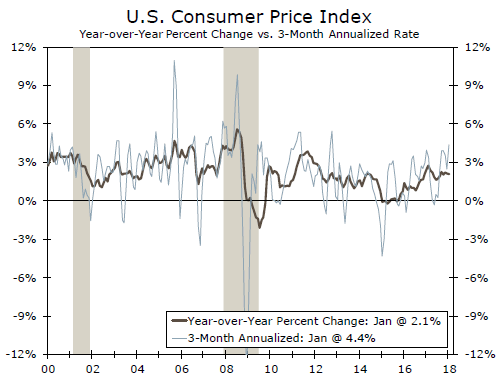
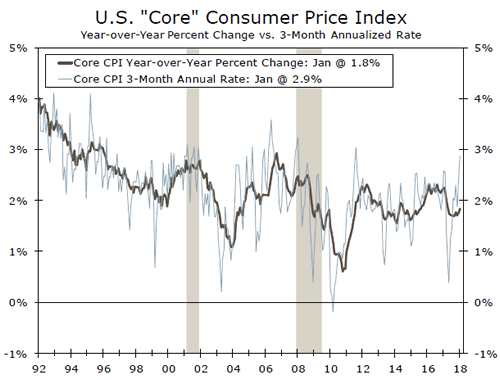
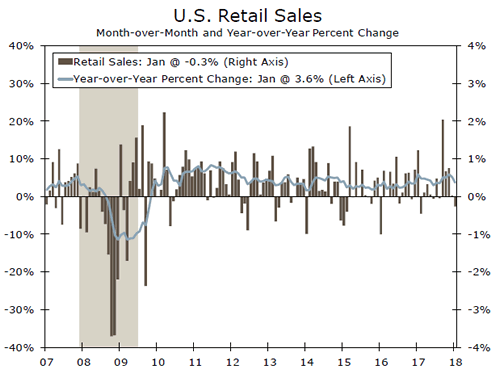
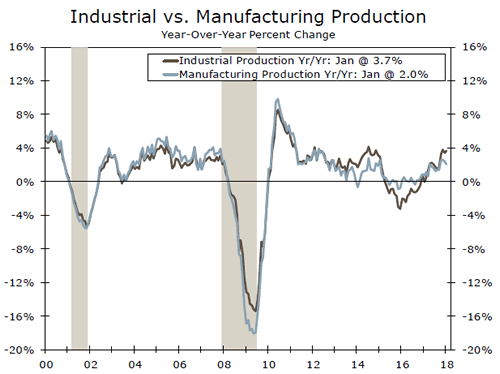
U.S. Outlook
Existing Home Sales • Wednesday
Existing home sales fell 3.6 percent in December to a 5.57 million unit pace following a strong 5.1 percent increase in November. The challenge remains in the existing housing market of continued tight inventories which, in turn, are driving up existing home prices and weighing on affordability. Existing home supply reached the lowest level (3.2 months) since the National Association of Realtors has been tracking the measure in 1999. The median price of an existing home is up 5.8 percent on a year-over-year basis. Even with these challenges, for total year 2017, overall sales rose 1.1 percent relative to 2016 to a 5.51-million unit pace. We expect existing home sales to start the year on a firmer note, rising 1.4 percent to a 5.65-million unit pace in January. In 2018, we expect existing home sales to rise to a 5.67-million unit pace. Our forecast for median existing home prices calls for a 5.6 percent increase in 2018.
Previous: 5.57 Million Wells Fargo: 5.65 Million Consensus: 5.61 Million
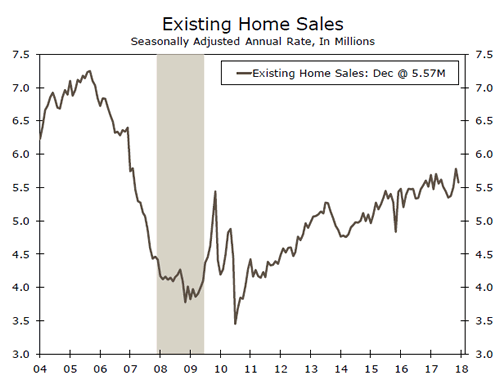
FOMC Meeting Minutes • Wednesday
The Federal Open Market Committee left the federal funds range unchanged in January. Analysts will be looking closely at the minutes from the January meeting to look for further clues on the future rate hike path. Given the recent string of inflation readings, markets will be looking closely for concerns from the FOMC about the possibility of falling behind the curve in reacting to a rising inflation environment. That said, with a new FOMC composition this year the January meeting minutes may not hold too many clues. Currently, markets are pricing in a 99 percent probability of another rate hike at the March FOMC meeting. Our view is for three rate hikes this year beginning with the March meeting and subsequent hikes in Q2 and Q3 of this year. That said, should inflation continue to surprise to the upside, the risk of more rate hikes may start building as the year progresses.
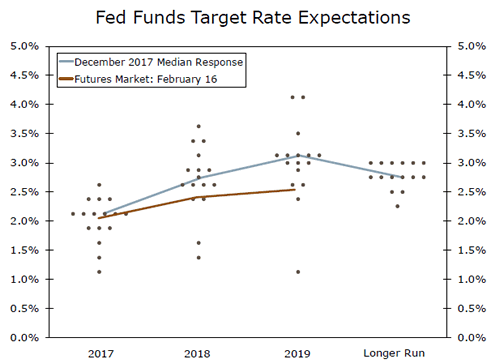
Leading Economic Index • Thursday
The Leading Economic Index rose 0.6 percent in December, marking the 16th month of consecutive gains in the measure. The leading index reached 9.9 percent on a three-month annualized basis. One of the biggest contributors to the strong reading was the Institute for Supply Management’s new orders component, which added 0.29 percentage points to the index. We expect the LEI will post another sizable gain in January of 0.8 percent. The measure should be led higher once again by the ISM new order component given the continued strengthen observed in both the ISM manufacturing and non-manufacturing new order components in January. The LEI continues to point toward a robust economic growth environment in the quarters ahead, consistent with our forecast for GDP growth between 2.5 and 3.0 percent on an annualized basis.
Previous: 0.6% Wells Fargo: 0.8% Consensus: 0.7% (Month-over-Month)
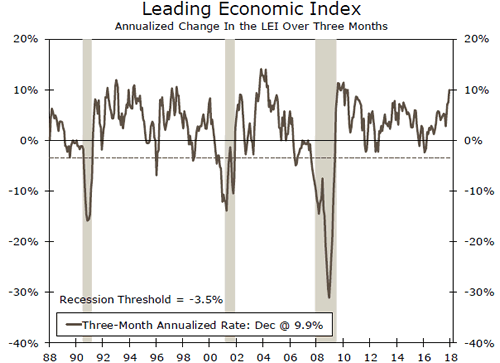
Global Review
Slow But Steady Expansion Continues in Japan
- The sequential rate of real GDP growth was a tad disappointing in Q4. That said, the Japanese economy has actually been performing rather well recently. Real GDP growth has been positive for eight consecutive quarters, the longest string of uninterrupted expansion in 30 years.
Another Bank of England Rate Hike Looming?
- U.K. CPI inflation was higher than expected in January, which raises the odds that the Bank of England may hike rates as early as May. However, weaker-than-expected data on consumer spending may keep the bank on hold a bit longer.
Slow But Steady Expansion Continues in Japan
Data released this week showed that real GDP in Japan edged up at an annualized rate of only 0.5 percent in Q4-2017 relative to the previous quarter (see graph on front page). Not only was the outturn weaker than most analysts had expected, but it was also the slowest sequential rate of GDP growth in two years.
Although the headline rate of GDP growth in Q4 may have been a tad disappointing, the Japanese economy has actually been performing rather well recently. Real GDP in Japan grew 1.6 percent in 2017. Although this outturn may be underwhelming for many other economies, it was the strongest year for GDP growth in Japan since 2013. Moreover, real GDP growth has been positive for eight consecutive quarters, the longest string of uninterrupted expansion in 30 years. The unemployment rate in Japan has receded to a 23-year low below 3 percent.
Despite solid GDP growth over the past few years, inflation in Japan remains benign. Although the overall rate of CPI inflation is currently around 1 percent (top chart), the underlying rate of inflation, as measured by consumer prices less food and energy, is essentially zero percent at present. Until inflation becomes firmly entrenched in Japan, which probably will not be anytime soon, the Bank of Japan is not likely to alter its accommodative policy stance.
Another Bank of England Rate Hike Looming?
In contrast to Japan, inflation appears to be increasingly entrenched in the United Kingdom. Data released this week revealed that consumer prices rose 3.0 percent in January (middle chart). Not only was this overall rate of CPI inflation unchanged from the previous month, but it was higher than most analysts had expected. Furthermore, the core rate of inflation ticked up to 2.7 percent from 2.5 percent in December. Members of the Monetary Policy Committee (MPC) at the Bank of England, who are mandated by the government with achieving a 2 percent inflation rate, were probably not thrilled by the news.
We made some changes to our U.K. interest rate forecast in the Interest Rate Watch section of this report last week. Specifically, we had thought that the MPC would wait until the fourth quarter to hike rates again, but we moved it up to Q3 last week due to hawkish sounding commentary from the MPC. Some analysts now look for the MPC to hike rates in May after the inflation data this week. However, lackluster data on British economic activity could stay the MPC’s hand. The deceleration in consumer spending that has been evident for the past year or so continued in January as real retail sales edged up only 0.1 percent relative to the previous month (bottom chart). The rise in inflation has eroded growth in real income, which is weighing on growth in real consumer spending. Uncertainties related to Brexit are compounding the weight on the economy.
We are sticking to our forecast of a rate hike in Q3, at least for the time being, but acknowledge the risk that it may occur sooner. If inflation surprises to the upside again and/or spending data come in stronger than expected in the next month or two, we may need to bring forward our forecasted rate hike yet again. Stay tuned.
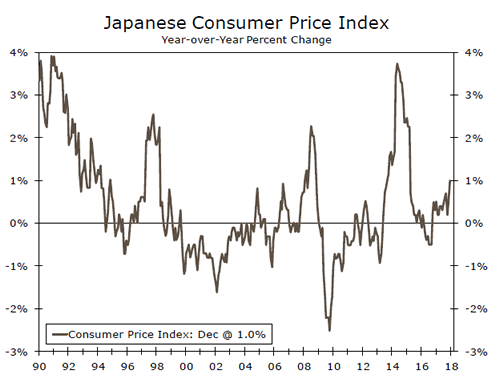
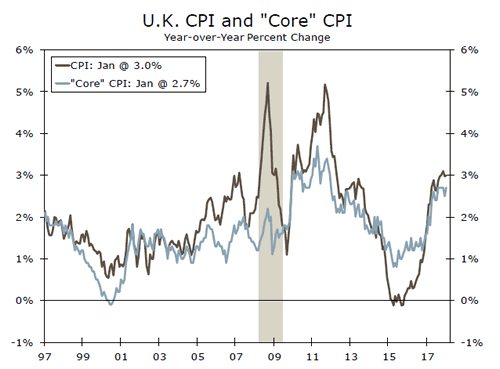
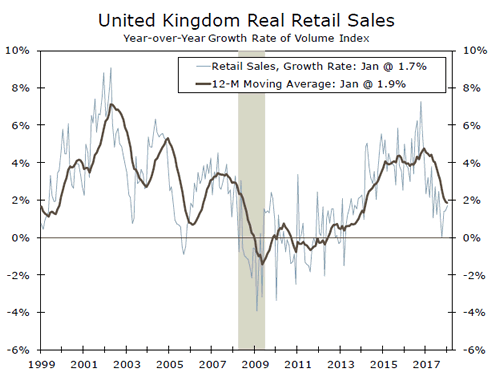
Global Outlook
U.K. Unemployment • Wednesday
The annualized rate of GDP growth in the U.K. economy picked up a bit in the final quarter of 2017 according to the initial estimate released a few weeks ago, but after slower growth in prior quarters, the year-over-year rate of growth was the weakest in more than four years. A revision to fourth quarter U.K. growth is due out on Thursday of next week.
One headwind for U.K. economic growth is that real disposable income growth weakened over the course of 2017. That may be poised to change as the downward trend in the unemployment rate may eventually result in a pickup in disposable income. That is the reason the financial market in the United Kingdom will be paying particularly close attention to the release of the latest unemployment figures on Wednesday of this coming week.
Previous: 4.3% Consensus: 4.3%
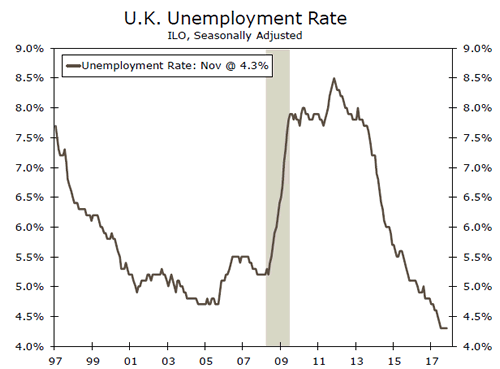
Japanese CPI • Friday
Japanese GDP growth for the fourth quarter came in at an annualized rate of just 0.5 percent, which was below the consensus expectation of 1.0 percent. The underlying details were encouraging as strong consumer spending growth resulted in a pick-up in imports which resulted in part of the drag on the headline growth rate.
At its latest policy meeting, the Bank of Japan (BoJ) said that it is "not even thinking about" normalizing monetary policy there. The BoJ remains committed to providing an accommodative policy environment even as it is running into some capacity constraints in terms of the share it owns of Japanese Government Bonds and other securities. The BoJ is committed to driving CPI inflation higher. Friday of this coming week brings the January report for CPI and we expect to see a print of 1.4 percent, still well below the BoJ’s 2.0 percent target.
Previous: 1.0% Wells Fargo: 1.4% Consensus: 1.3% (Year-over-Year)
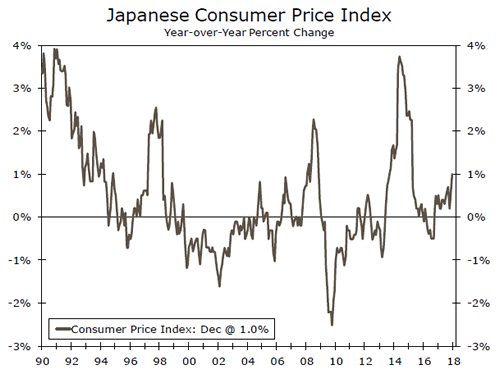
Canadian CPI • Friday
Speaking of central banks, the Bank of Canada (BoC) can look forward to new CPI data on Friday as well. The BoC aims to keep inflation between 1.0 and 3.0 percent, ideally at the midpoint of 2.0 percent. On that basis, it looks as though things are right in line with its objective as CPI inflation in December came in at 1.9 percent.
Our expectation is that CPI for January will come in much slower. The sudden drop-off here in the year-over-year rate is largely attributable to base effects as January of 2017 saw a significant jump up (0.9 percent) in consumer prices. "One month does not a trend make" and we expect the BoC to look through what is likely to be only a temporary slowdown in prices as it weighs its policy decisions for 2018. The next move from the BoC is likely to be an increase in the overnight rate, though we suspect a hike more likely at the April 18 meeting rather than at the upcoming one on March 7.
Previous: 1.9% Wells Fargo: 1.2% (Year-over-Year)
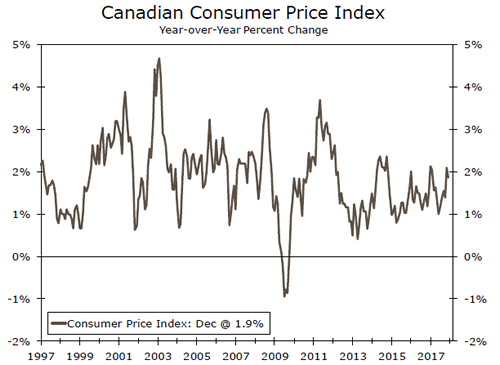
Point of View
Interest Rate Watch
Markets Finally Believing in Inflation
Strong CPI and PPI readings to start 2018 appear to have convinced markets that higher inflation has finally arrived and, as a result, the Fed is more likely to raise rates a few times this year. Treasury yields moved noticeably higher this week, with the 10-year yield reaching over 2.90 percent on Wednesday.
Rising spreads between nominal and inflation-linked Treasuries (TIPS) confirmed higher market expectations for inflation. The difference between the yield on 5-year nominal and TIPS notes, a gauge of short-term market inflation expectations, rose to the highest level since March 2017.
Far From Getting Out of Hand
While markets are finally coming around to our view that higher inflation is in the offing, it is worth noting that inflation is unlikely to come unhinged any time soon.
A tight labor market should lead to higher labor costs, but higher labor costs need not lead to significantly higher inflation. The pass-through of wages to inflation has weakened over the past few decades. If productivity picks up, as we expect given stronger capital spending, rising labor costs could be absorbed by greater output/sales. Alternatively, companies could give up some profit margins, but even that may not need to be the case following the recent tax bill.
Inflation expectations also remain fairly low, suggesting the pickup in inflation will be gradual. Consumer and market based inflation expectations have improved the past few months, but are still below the levels that preceded the commodity price slide that began mid-2014. Along with structural headwinds to inflation like the shift to e-commerce and historically low healthcare inflation, we expect core CPI to run only slightly above 2 percent this year.
FOMC officials were already anticipating a pickup in inflation this year, with a median forecast of 1.9 percent for core PCE inflation by the fourth quarter versus 1.5 percent currently. The recent pickup in inflation should therefore not throw a wrench in the Fed’s plans to hike rates only gradually in the coming quarters.
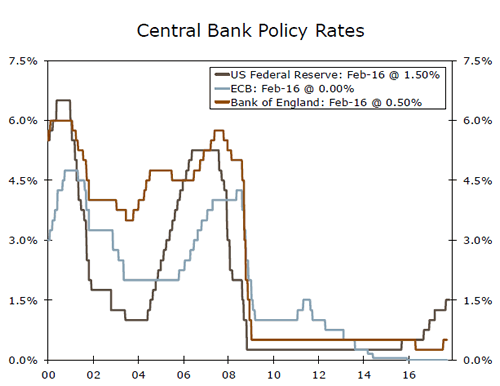
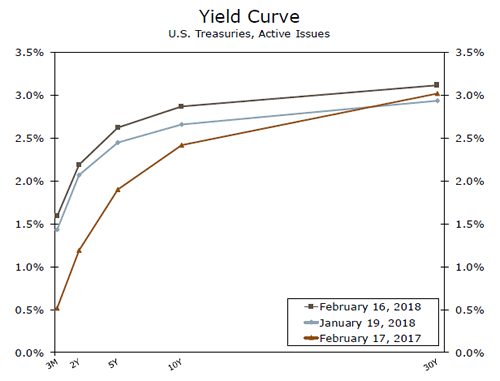
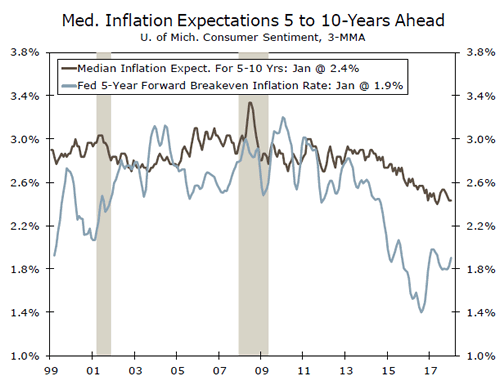
Credit Market Insights
Household Debt: Daring, not Delinquent
The New York Federal Reserve’s Quarterly Report on Household Debt and Credit revealed that total household debt reached a new peak in Q4-2017, rising to $13.15 trillion, eclipsing the previous high set in Q3-2008. This now marks the 14th consecutive quarter that household balances have increased. Mortgage balances, which is the largest component of household debt, comprising 68 percent of total household debt, increased by $139 billion over the quarter. To put the jump into perspective, auto loans grew by $8 billion and credit card balances increased by $26 billion, while student loans grew by $21 billion. Auto and student loans continue to increase as a percent of the total outstanding household debt profile.
Despite the fact that the amount of outstanding debt is growing and interest rates are rising, delinquency rates have not ticked up in any meaningful way; in many cases, delinquency rates are improving. Mortgage delinquency rates for current mortgage balances ticked down, while aggregate student loan debt that was delinquent or in default declined from the previous quarter. Moreover, the number of credit inquiries within the past six months declined in the fourth quarter. Auto loan delinquency rates increased slightly, with 4.1 percent of loan balances 90 or more days overdue in Q4.
With consecutive months of inflation surprises to the upside, the Fed may consider accelerating along its tightening path. Although we are not calling for such a situation at this point, faster than expected rate hikes would certainly put pressure on borrowing.
Topic of the Week
The Return of Trillion Dollar Deficits
As interest rates continue to rise in the United States, the federal budget deficit has returned to center stage after spending years on the backburner. The combination of tax cuts, the recent spending deal and structural budget pressures related to the aging of the population have led analysts, including us, to predict the imminent return of trillion dollar deficits in the United States (top chart).
In light of the recent budget agreement, we have adjusted our FY 2018 budget deficit forecast to $775 billion (from $750 billion) and moved our FY 2019 forecast to $1.1 trillion (from $950 billion). The relatively modest increase in our FY 2018 forecast is the result of two offsetting factors: a larger-than-expected increase in the budget caps and a later-than-expected enactment. FY 2018 is more than one-third complete, and Congress still has to pass another bill appropriating the new money by March 23. Thus, the actual outlays for the current fiscal year will likely come in well below the new budget authority granted, pushing some spending into next year.
As a result, the stars are aligning for the return of trillion dollar deficits in FY 2019. Our $1.1 trillion forecast comes at a time when the economy is growing faster than potential and the unemployment rate is approaching sub- 4 percent (bottom chart). The relatively strong economy is mitigating the deficit impact to an extent; were the economy to underperform, the deficit over the next year and a half would likely be even larger, all else equal.
The Trump administration has expressed a desire for more fiscal stimulus in the form of an infrastructure plan. Even with state & local governments and private sources chipping in a large chunk of the funding, the proposals thus far have failed to gain traction over the lack of a consensus funding-source and growing fatigue over deficit-financed stimulus in a healthy economy.
Were an infrastructure plan to become law, the drivers of higher interest rates we outlined in a report earlier this year would likely be reinforced: faster economic growth, faster inflation and larger budget deficits.
